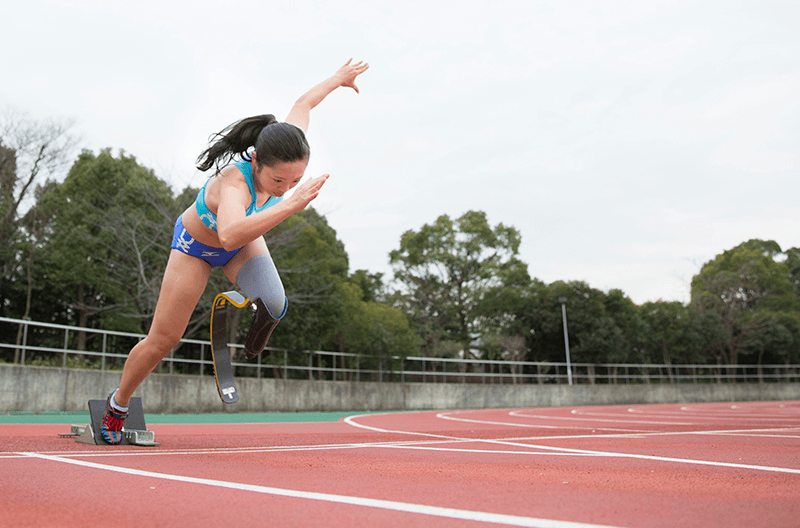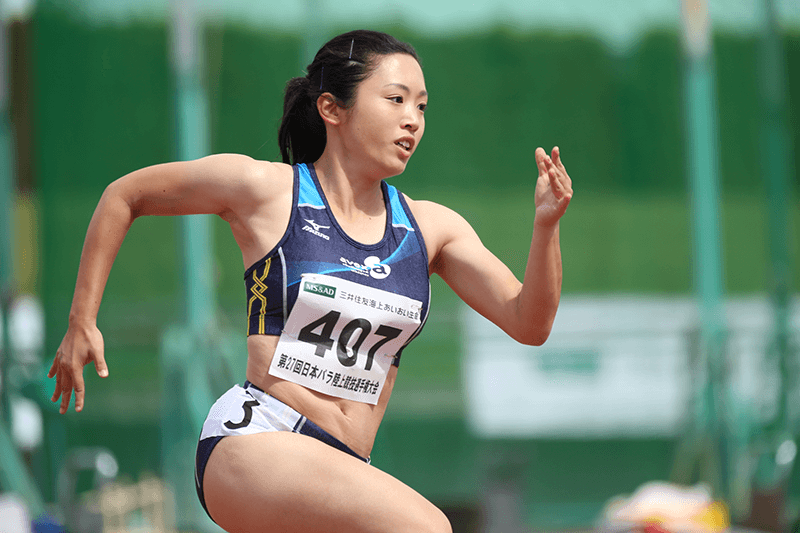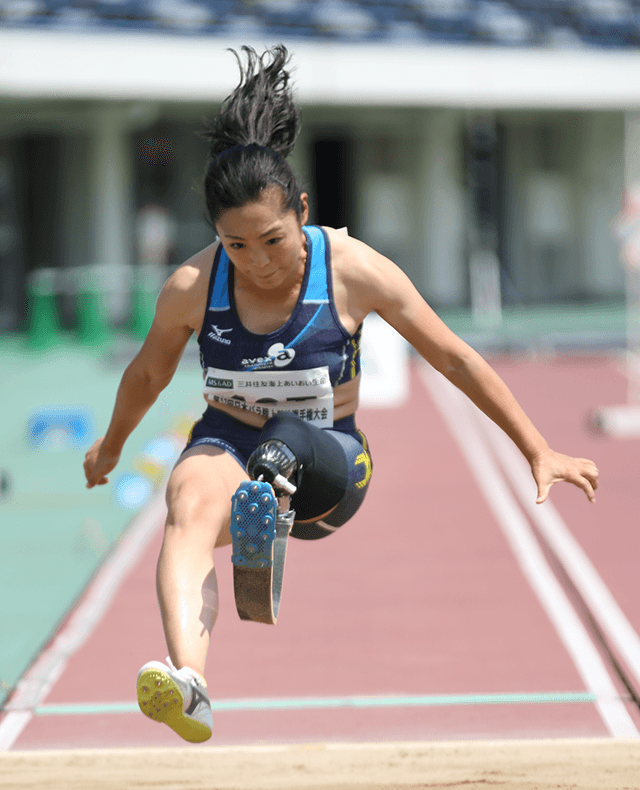Now preparing for the 2016 Paralympics, long jumper Saki Takakuwa opens up about overcoming the tragedy of losing a limb, and what she believes needs to change in Japan before 2020.
Saki Takakuwa was training for a school athletics meet when she first felt a twinge in her leg. Tragically, what she initially thought was a simple strain turned out to be a tumor below her left knee. Surgery followed, but the condition showed no sign of improvement, and shortly after starting junior high school she was diagnosed with bone cancer (osteosarcoma). A few weeks later the lower part of her left leg was amputated.
“It was a difficult time,” she says matter-of-factly. “I returned to school with a part of my body missing, mask on and hair falling out because of the chemotherapy. It must have been a shocking sight for my classmates who chose to deal with it by remaining silent. A teacher told my mum that it was their way of showing sensitivity. Of course I could understand that, yet I felt so alone. It was really hard not being able to convey my feelings to anyone.”
Takakuwa found some solace in Mami Sato’s book “Lucky Girl.” A long jumper who competed in three Paralympics, Sato became a household name in Japan following her “I’m here because I was saved by sport” speech, which helped Tokyo’s successful bid for the 2020 Olympic and Paralympic Games. Like Takakuwa, she lost part of her leg due to osteosarcoma.
“It was inspiring to read such a positive story by someone who’d gone through something similar to me,” Takakuwa says. “Her book made me realize there were opportunities out there and that I didn’t necessarily have to give up on sport. At a real dark time in my life, it gave me encouragement, but that doesn’t mean I suddenly decided to become a Paralympian. At that point I wasn’t really thinking about my future at all. It was just about getting through each day.”
The first challenge for Takakuwa was learning how to walk again with her new prosthetic leg. Then, in her second year at junior high school, she attempted to run 50m in a PE lesson. Despite a hesitant start, she managed to cross the finish line. “It was an exhilarating feeling to be back on the track,” she tells us. “At the same time, though, I was also a bit frustrated at not being able to run as fast as I did before all the surgeries.”
The Saitama Prefecture native started out with a prosthetic used for daily life, but later switched to a J-shaped one preferred by athletes at the Paralympics. It proved tough early on from both a physical and psychological perspective, however, when she got used to the artificial limb her times improved rapidly. She trained every day at an athletics club with able-bodied runners, and in her second grade at high school she was selected for an Asian Para Youth event in Tokyo. At the age of 20, she qualified for her first Paralympics, representing Japan at the 2012 London Games in the 100m and 200m sprints as well as the long jump (all T44 classifications).
“I felt lucky to be there,” she says. “Unfortunately I didn’t make the long jump final, but I did get through in the 100m and 200m, finishing seventh in both. The results were more than satisfying and the whole experience was amazing. Of course it was my first Paralympics so I’ve nothing to compare it to, but you could tell there was something special about the event. I wanted to spend as long as possible on the track so I could properly take in the atmosphere.”
Widely regarded as the greatest Paralympics to date, the London Games had more participants, larger audiences and wider media coverage than ever before. Focusing on sporting excellence rather than competitors’ disabilities, there was a tidal wave of excitement at the time and the hope is that it’ll continue in Brazil and Japan. Early indications aren’t so positive, though. Just a few weeks before the 2016 Paralympics, only 12 percent of the tickets had been sold, and as a result major budget cuts were expected. Sales for the Tokyo Games should be much higher, yet Takakuwa believes much needs to be done in this country before the event arrives here in 2020.
“While progress is being made in Japan, it’s happening at a very slow pace,” she says. “There are few tournaments here so we have to go abroad to compete. For up-and-coming athletes, it remains a real struggle to get sponsorship. [Saki’s teammate Maya Nakanishi raised funds for the 2012 Games by publishing a semi-nude calendar.] As well as a lack of money, there’s a shortage of venues and training centers. Another issue is infrastructure. Many buildings in Tokyo aren’t well equipped for people with disabilities or tourists with suitcases. As I said, things are gradually improving and Japan has learnt from the London Paralympics, which is positive. I just hope things can develop at a quicker pace over the next four years.”
Takakuwa will be 28 then so should just be reaching her peak. The focus for now, though, is Rio and the three events she’ll once again be featuring in this month. The long jump used to be the discipline she concentrated on least, but recent form suggests this could be her best chance of a medal in Brazil. At major international events in Doha and London last year against the world’s top jumpers, she managed to finish third on both occasions and is getting closer to the five meter mark. Competing against able-bodied athletes at the Kawasaki Grand-Prix in May will have given her confidence a further boost. As for the sprints, her form isn’t looking as good, which is a concern considering she believes that a personal best will be required in both the 100m and 200m to reach the finals.
“In Qatar I was knocked out at the qualifying stages for both sprints, which was a real wake-up call,” she says. “It was at that point that my coach and I both realized that the world had got faster and I needed to up my game. In London I finished seventh in the 100m with a time of 14.22, whereas in Rio I think I’ll need to go under 13.5 just to reach the final. My best time is 13.69 so it’s going to be tough. The quality of the field is constantly getting better. As well as experienced champions such as Marie-Amélie Le Fur (France), you also have exciting youngsters like Sophie Kamlish (UK) coming through. I’m looking forward to competing against them and I just hope I can reach my goal of improving on London.”
Paralympics Through the Ages
1948 To coincide with the first post-war Olympics held in London, neurologist Dr. Ludwig Guttmann decided to organize a competition involving WWII veterans with spinal cord injuries at a rehabilitation facility in Aylesbury, England. It was called the 1948 International Wheelchair Games, though only Brits competed. Four years later, the Netherlands joined the event.
1960 The first official Paralympics – only for athletes in wheelchairs, but not open solely to war veterans – took place in Rome in 1960. An impressive 400 competitors from 23 countries took part. As there were no more than three athletes or teams per event, everyone was guaranteed a medal.
1976 Those numbers increased to 1,600 competitors from 40 countries at the Toronto Games in 1976. For the first time, amputees and visually impaired athletes were allowed to compete. The maiden Winter Paralympics also took place that year in Ornskoldsvik, Sweden.
2000 From 1996, athletes with intellectual disabilities were allowed to participate at the Paralympics. An IQ of less than 70 was required. Just two of Spain’s 12-man basketball squad at the 2000 Games had genuine disabilities. The other 10 used fake medical certificates. They beat China in the final, but were later stripped of their medals. Undercover journalist, Carlos Ribagorda, who played in the team, claimed Spain had also faked disabilities in other sports.
2012 After receiving a suspension for the 2004 and 2008 Games, competitions involving athletes with intellectual disabilities returned in 2012, albeit with greater scrutiny and sports intelligence tests determining eligibility. The London Paralympics was the biggest ever with 4,302 athletes from 164 countries. There were a total of 503 events in 20 sports.
To stay updated on Takakuwa’s progress and follow the latest news from the Rio 2016 Paralympics, visit https://www.rio2016.com/en.











